BBC News Mundo
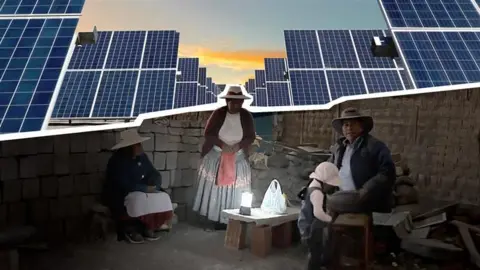 BBC
BBCEach morning, Rosa Chamami wakes to flames licking at cardboard scraps in a makeshift stove in her yard.
The boxes she brought home once held 800,000 high-tech solar panels. Now, they fuel her fire.
Between 2018 and 2024, those panels were installed at Rubí and Clemesí, two massive solar plants in Peru’s Moquegua region, about 1,000 kilometres south of the capital, Lima. Together, they form the country’s largest solar complex – and one of the biggest in Latin America.
From her home in the small settlement of Pampa Clemesí, Rosa can see the rows of panels glowing under white floodlights. The Rubí plant is just 600 metres away.
Yet her home – and the rest of her village – remains in total darkness, unconnected to the grid the plant feeds into.
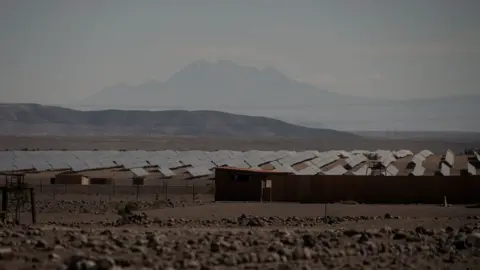
Power from the sun, but not at home
None of Pampa Clemesí’s 150 residents have access to the national power grid.
A few have solar panels donated by Rubí’s operator, Orygen, but most can’t afford the batteries and converters needed to make them work. At night, they use torches – or simply live in the dark.
The paradox is striking: the Rubí solar power plant produces around 440 GWh a year, enough to supply electricity to 351,000 homes. Moquegua, where the plant is located, is an ideal site for solar energy, receiving over 3,200 hours of sunshine annually, more than most countries.
And that contradiction becomes even sharper in a country currently experiencing a renewable energy boom.
In 2024 alone, electricity generation from renewables grew by 96%. Solar and wind power depend heavily on copper due to its high conductivity – and Peru is the world’s second-largest producer.
“In Peru, the system was designed around profitability. No effort was made to connect sparsely populated areas,” explains Carlos Gordillo, an energy expert at the University of Santa María in Arequipa.
Orygen says it has fulfilled its responsabilities.
“We’ve joined the government project to bring electricity to Pampa Clemesí and have already built a dedicated line for them. We also completed the first phase of the electrification project, with 53 power towers ready to operate,” Marco Fragale, Orygen’s executive director in Peru, told BBC News Mundo, the BBC’s Spanish-language service.
Fragale adds that nearly 4,000 metres of underground cable were installed to provide a power line for the village. The $800,000 investment is complete, he says.
But the lights still haven’t come on.
The final step – connecting the new line to individual homes – is the government’s responsibility. According to the plan, the Ministry of Mines and Energy must lay about two kilometres of wiring. Work was slated to begin in March 2025, but hasn’t started.
BBC News Mundo tried to contact the Ministry of Mines and Energy but received no response.
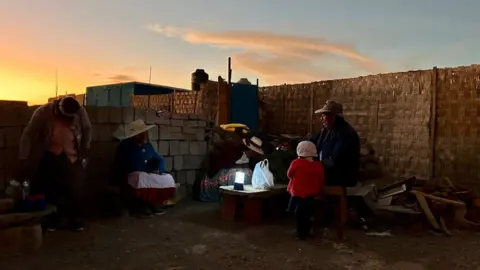
A daily struggle for basics
Rosa’s tiny house has no sockets.
Each day, she walks around the village, hoping someone can spare a bit of electricity to charge her phone.
“It’s essential,” she says, explaining she needs the device to stay in touch with her family near the border with Bolivia.
One of the few people who can help is Rubén Pongo. In his larger home – with patios and several rooms – a group of speckled hens fights for rooftop space between the solar panels.
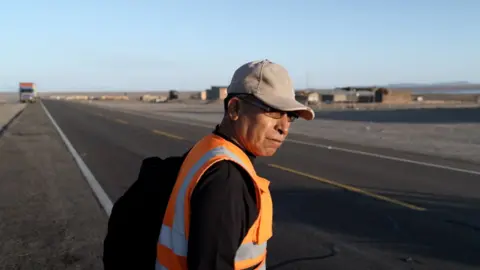
“The company donated solar panels to most villagers,” he says. “But I had to buy the battery, the converter, and the cables myself – and pay for installation.”
Rubén owns something others only dream of: a fridge. But it only runs for up to 10 hours a day, and on cloudy days, not at all.
He helped build the Rubí plant and later worked in maintenance, cleaning the panels. Today, he manages the warehouse and is driven to work by the company, even though the plant is just across the road.
Crossing the Pan-American Highway on foot is prohibited by Peruvian law.
From his rooftop, Rubén points to a cluster of glowing buildings in the distance.
“That’s the plant’s substation,” he says. “It looks like a little lit-up town.”
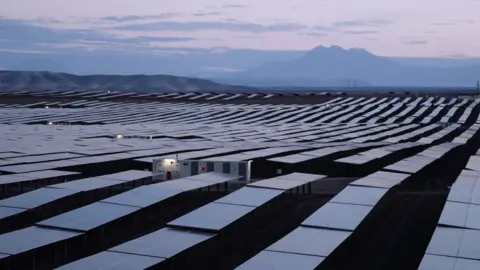
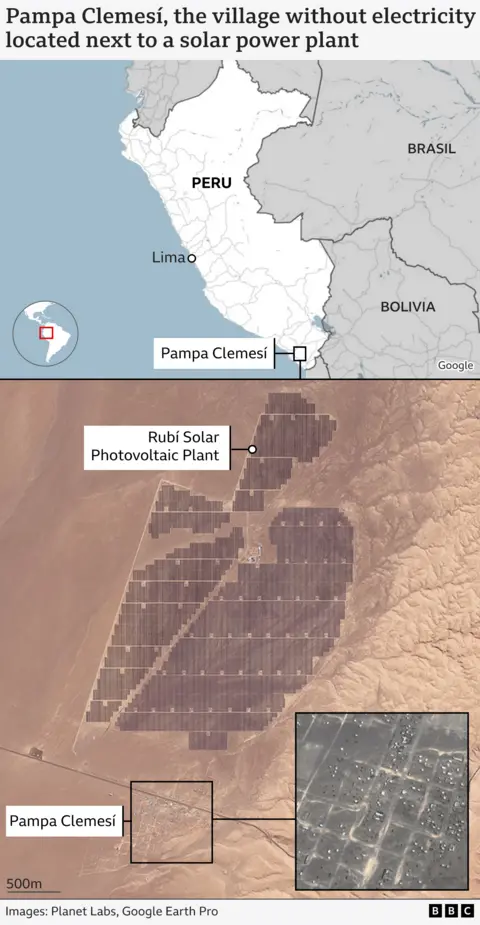
A long wait
Residents began settling in Pampa Clemesí in the early 2000s. Among them is Pedro Chará, now 70. He’s watched the 500,000-panel Rubí plant rise almost on his doorstep.
Much of the village is built from discarded materials from the plant. Pedro says even their beds come from scrap wood.
There’s no water system, no sewage, no rubbish collection. The village once had 500 residents, but due to scarce infrastructure, the majority left – especially during the COVID-19 pandemic.
“Sometimes, after waiting so long, fighting for water and electricity, you just feel like dying. That’s it. Dying,” he says.
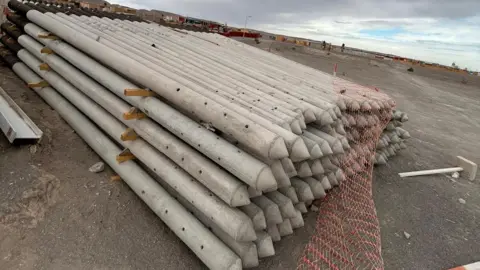
Dinner by torchlight

Rosa hurries to her aunt’s house, hoping to catch the last of the daylight. Tonight, she’s cooking dinner for a small group of neighbours who share meals.
In the kitchen, a gas stove heats a kettle. Their only light is a solar-powered torch. Dinner is sweet tea and fried dough.
“We eat only what we can keep at room temperature,” says Rosa.
Without refrigeration, protein-rich foods are hard to store.
Fresh produce requires a 40-minute bus ride to Moquegua – if they can afford it.
“But we don’t have money to take the bus every day.”
With no electricity, many in Latin America cook with firewood or kerosene, risking respiratory illness.

In Pampa Clemesí, residents use gas when they can afford it — wood when they can’t.
They pray by torchlight for food, shelter, and water, then eat in silence. It’s 7pm, their final activity. No phones. No TV.
“Our only light is these little torches,” Rosa says. “They don’t show much, but at least we can see the bed.”
“If we had electricity, people would come back,” Pedro says. “We stayed because we had no choice. But with light, we could build a future.”
A soft breeze stirs the desert streets, lifting sand. A layer of dust settles on the lampposts on the main plaza, waiting to be installed. The wind signals that dusk is coming – and that soon, there will be no light.
For those without solar panels, like Rosa and Pedro, the darkness stretches on until sunrise. So does their hope that the government will one day act.
Like so many nights before, they prepare for another evening without light.
But why do they still live here?
“Because of the sun,” Rosa replies without hesitation.
“Here, we always have the sun.”





